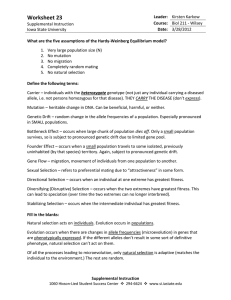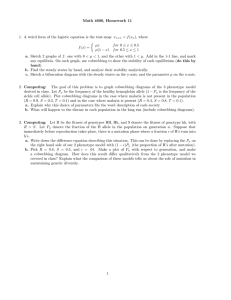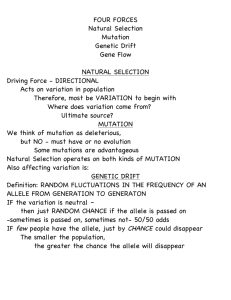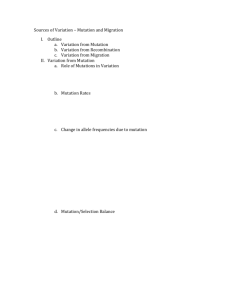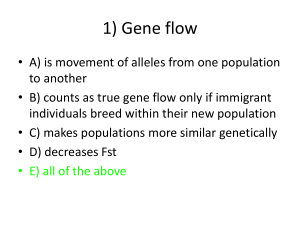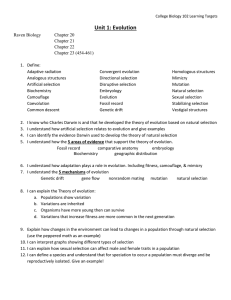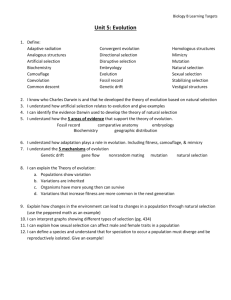Laboratory 1 Part 2: Forces of evolution
advertisement
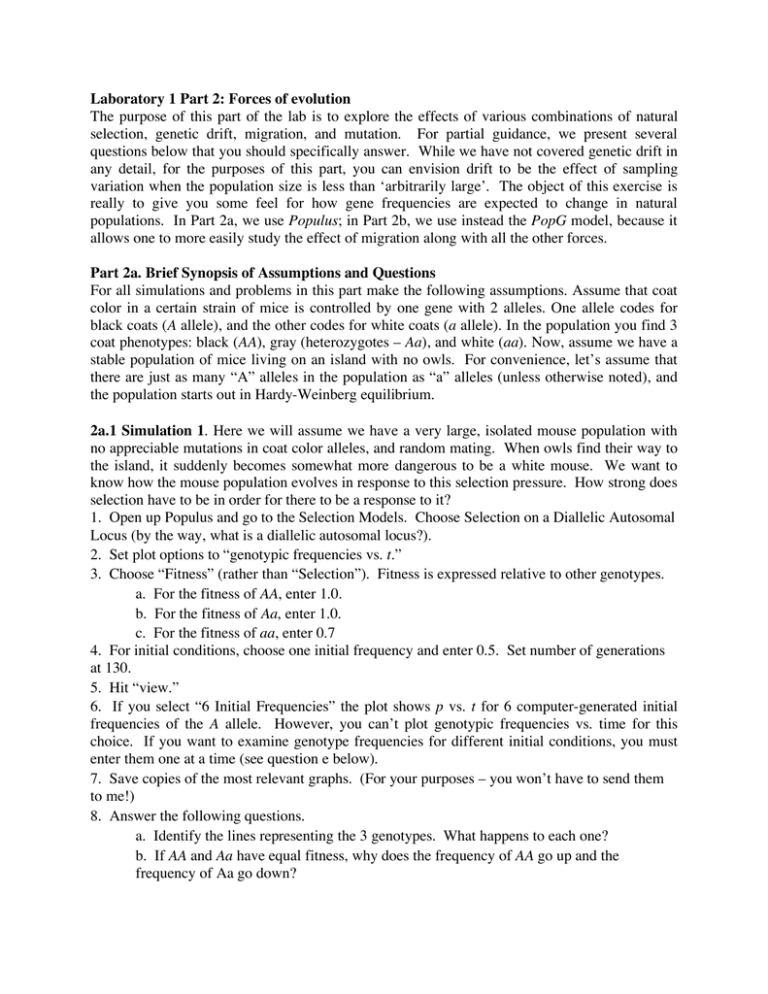
Laboratory 1 Part 2: Forces of evolution The purpose of this part of the lab is to explore the effects of various combinations of natural selection, genetic drift, migration, and mutation. For partial guidance, we present several questions below that you should specifically answer. While we have not covered genetic drift in any detail, for the purposes of this part, you can envision drift to be the effect of sampling variation when the population size is less than ‘arbitrarily large’. The object of this exercise is really to give you some feel for how gene frequencies are expected to change in natural populations. In Part 2a, we use Populus; in Part 2b, we use instead the PopG model, because it allows one to more easily study the effect of migration along with all the other forces. Part 2a. Brief Synopsis of Assumptions and Questions For all simulations and problems in this part make the following assumptions. Assume that coat color in a certain strain of mice is controlled by one gene with 2 alleles. One allele codes for black coats (A allele), and the other codes for white coats (a allele). In the population you find 3 coat phenotypes: black (AA), gray (heterozygotes – Aa), and white (aa). Now, assume we have a stable population of mice living on an island with no owls. For convenience, let’s assume that there are just as many “A” alleles in the population as “a” alleles (unless otherwise noted), and the population starts out in Hardy-Weinberg equilibrium. 2a.1 Simulation 1. Here we will assume we have a very large, isolated mouse population with no appreciable mutations in coat color alleles, and random mating. When owls find their way to the island, it suddenly becomes somewhat more dangerous to be a white mouse. We want to know how the mouse population evolves in response to this selection pressure. How strong does selection have to be in order for there to be a response to it? 1. Open up Populus and go to the Selection Models. Choose Selection on a Diallelic Autosomal Locus (by the way, what is a diallelic autosomal locus?). 2. Set plot options to “genotypic frequencies vs. t.” 3. Choose “Fitness” (rather than “Selection”). Fitness is expressed relative to other genotypes. a. For the fitness of AA, enter 1.0. b. For the fitness of Aa, enter 1.0. c. For the fitness of aa, enter 0.7 4. For initial conditions, choose one initial frequency and enter 0.5. Set number of generations at 130. 5. Hit “view.” 6. If you select “6 Initial Frequencies” the plot shows p vs. t for 6 computer-generated initial frequencies of the A allele. However, you can’t plot genotypic frequencies vs. time for this choice. If you want to examine genotype frequencies for different initial conditions, you must enter them one at a time (see question e below). 7. Save copies of the most relevant graphs. (For your purposes – you won’t have to send them to me!) 8. Answer the following questions. a. Identify the lines representing the 3 genotypes. What happens to each one? b. If AA and Aa have equal fitness, why does the frequency of AA go up and the frequency of Aa go down? c. If aa is bad, why doesn’t that genotype disappear entirely? Why doesn’t the a allele disappear? In fact, go back to the Plot Options box and check “p vs. t”. This shows how the allele frequency (p = frequency of allele A) changes over time. What do you see? d. What does this simulation tell us about the relationship between fitness and genotypic frequency? e. Change the initial frequency of the A allele to 0.1 (leave everything else the same). In other words, we’re assuming that for whatever reason, white mice outnumber dark mice on the island prior to the arrival of owls. So, why does the aa line start so high and drop so fast? Why does Aa increase, then decrease? g. Plot “p vs. t” for this scenario. What does this tell you about how selection can work? 2a.2 Simulation 2. Here we will simulate the same large, isolated population of mice with no appreciable mutation in coat color alleles, random mating, and where individuals with white coats are spotted most frequently by predators, individuals with black coats are the next most frequently spotted, and gray individuals are rarely spotted by predators. In the same Populus model, using Selection on a Diallelic Autosomal Locus, set everything up as before, except that this time, set the fitness of the AA allele at 0.9 (with Aa at 1.0 and aa at 0.7). Questions: a. What is the equilibrium condition? b. What are the major differences between this simulation and the previous one? Part 2b. Systematic exploration of the forces – a summary study OK, now that you’ve had some practice investigating the basics we would like to give you some feel for how gene frequencies are expected to change in natural populations. To that end, we’d like you to explore the effects of various combinations of natural selection, genetic drift, migration, and mutation. For this purpose, you will use the PopG program – it is not as flexible as Populus, but it does one thing well: one-locus, two allele simulations, with selection, mutation, migration, and drift. Drift is built-in because you specify the population size. (Please refer to the web page cited for instructions on how to use PopG given in lab 1 part 1.) You might want to start with no mutation and no migration and look at the effects of natural selection including overdominance, as suggested below. Then perhaps look at the effect of mutation versus selection. You may also want to examine the effect of genetic drift alone by making all fitnesses equal, and the sizes of the other effects necessary to have a noticeable effect on the outcome in the face of drift. Be creative, but with some ability to compare results with other cases that differ in useful ways. After you’re done, write up what you’ve found out in 2-5 pages. To provide a bit of framework, we pose the following specific questions, which you should address in your report. You should make sure your report does answer each of them – but in addition, goes beyond just a point-by-point answer to attempt some generalizations. (In particular, I don’t provide any focused questions on drift – but you should still investigate that and include a discussion in your report.) Selection Consider a number of populations (8-10 is fine) that have their population size (N) being 1000 individuals, and no mutation. 1. Try cases with no mutation and no migration and all fitness values set to 1.0 (i.e. there is no selection). Does genetic drift in a population of size 1000 accomplish roughly the same changes in 1000 generations as genetic drift in a population of size 100 does in 100 generations? By running a number of simulations, check whether the probability that an allele is fixed by genetic drift is equal to its initial frequency in the populations – is this true or not? 2. Try a case with no mutation and migration, with the A allele favored by natural selection (with fitness of the AA genotype set highest and fitness of the aa genotype set lowest). Start with a small frequency of A. Is it always fixed? If one starts with a single copy of the allele, how does the probability that A is fixed compare with the selection coefficient favoring it in the heterozygote (compared to the fitness of the aa genotype? Is this fixation probability larger than the one you would get with the same initial frequency with no selection? 3. Try overdominance (Aa having the highest fitness). Does the gene frequency converge towards an equilibrium? Why does it vary from this equilibrium frequency? How large do the selection coefficients have to be to cause the gene frequency to stay away from fixation or loss for large amounts of time? In particular, what happens when the fitness values of AA, Aa, and aa are 0.99, 1.0, and 0.99, respectively? 4. Try underdominance (Aa having the lowest fitness). Is there a starting gene frequency that will result in some populations heading for fixation, and others heading for loss? If you add a small amount of migration, what will happen if you add a small amount of mutation in both directions? 5. Comparison: With migration but no selection or mutation, how much migration is needed to make the gene frequency curves from questions 1-4 above all wind up quite similar to each other? How much is needed to make them all end up at the same gene frequency? Mutation alone & mutation vs. selection 6. With mutation but no selection or migration, how much mutation is needed to cause the gene frequencies to converge on a mutational equilibrium gene frequency? How does this value relate to the population size? 7. If an allele is selected against, can you set up mutation rates that will maintain it at low frequency in the population? 8. Also try different migration rates from 0 up to 0.1. For each, start the population with gene frequency 0.5. Describe the outcomes. I am not looking for detailed graphs of all runs but a general verbal description. However, distinguish between what happens with the different parameter values. Migration alone & migration vs. selection 9. Consider the number of individuals migrating into a typical population in one generation. What is it in terms of the population size N and the migration rate m? 10. Can you find a value of this number of new migrants, above which the outcome is different than below it (i.e. some value that is roughly the border between two kinds of behavior of the simulations)? What is the value? 11. With nonzero migration rates, do you ever find that the populations permanently fix for different alleles? Drift alone & drift vs. the other forces. Please don’t forget to explore this! PopG makes it easy to investigate this interaction…when would you judge that a population becomes ‘arbitrarily large’ in this two allele case?
